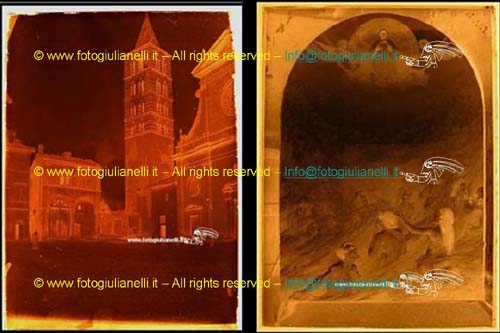SOME ORIGINAL PLATES
Plates
in “silver bromide gelatine”

1
2
ORIGINAL
PHOTOGRAPHIC PLATES:
1 – VITERBO –
Piazza del Duomo 1890
2 – VITERBO
- “Giudizio Universale” painted by Pietro Vanni on canvas

VITERBO – Porta S. Pietro - Oil
mill: the drying room
of olives
1840 – 1888. Towards
mass photography
The 49 years lasted from the officialising of the daguerreotype by the Academy of
France to the introduction of the Kodak N.1 in 1888 are significant
in the development of photographic techniques. At that time
the industry of modern photography spreaded out enormously.
Up to George Eastman’s
time all effort was put into improving sensitive materials. From the
daguerreotype to damp collodion the gap was very huge' because of the
fact that the sensibility of the emulsion increased ten times. While
using Talbot’s calotype it was not possibl to produce clear pictures,
good results were optained using Abel Niépce de Saint Victor’s negatives made
by albumen
on glass in 1847.
In 1851, a determining
improvement of the quality was achieved by
the introduction of the Frederick Scott Archer's damp collodion process. The
procedure was the treatment of the plate before the use i.e. the exposure
of the plate still damp. As a consequence, paper and albumen
negatives were overcome by the high sensibility
and definition of the damp collodion plates. However, the great
technical improvement was in 1871 when Robert Leach Maddox announced his system
for the production of dry-silver bromide plates.
Having acquired the
technology for focussing the images, the technicians begun to study
in order to obtaine coloured images. After many years of hand-painting with aniline, the
Scottish physicist James Clerk Maxwell made the first colour photo
by projecting at same time three negatives obtained through red, green and
blue filters (today we would say in RGB). Some years
later, Louis Ducos du Hauron made the first photographic colour
print with the trichromatic technique; du Hauron, on the
contrary to Maxwell, used complementary filters of colours printing on carbon
paper with pigments of the three primary colours.
It was the era of Gaspard-Félix Tournachon known as Nadar and of stereoscopic
photography, of the first war reports, of the establishment of many
industries; Voigtlaender, Zeiss, Steinheil, Dallmeyer, Agfa, Ilford,
Kodak, Konica , Leitz. Optics made great progress, so much that
someone concentrated himself on the scanning of images: Paul Nipkow, the
father of television, who in 1884 invented a disk for the transmission of images. Italy too,
even tough industrially depressed compared to
other countries had famous names: Michele Cappelli, Murer, Alinari, Francesco Negri, Carlo Ponti and many others.
In 1888, George
Eastman, a captain of industry, catched the moment and
launched his Kodak n.1. He was acknowledged as being the mane who
made popular the use of cameras. From that moment it was no longer
necessary to be an alchemist in order to take photos. Just “push the
button” as smartly advertised. (by Reflex online –
www.reflex.it).
OTHER
TYPES OF BOXES FOR PHOTOGRAPHIC PLATES
next
page >>

